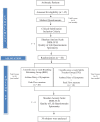Respiratory rehabilitation: a physiotherapy approach to the control of asthma symptoms and anxiety
- PMID: 23184206
- PMCID: PMC3488988
- DOI: 10.6061/clinics/2012(11)12
Respiratory rehabilitation: a physiotherapy approach to the control of asthma symptoms and anxiety
Abstract
Objectives: The objectives of this study were to verify the degree of anxiety, respiratory distress, and health-related quality of life in a group of asthmatic patients who have experienced previous panic attacks. Additionally, we evaluated if a respiratory physiotherapy program (breathing retraining) improved both asthma and panic disorder symptoms, resulting in an improvement in the health-related quality of life of asthmatics.
Methods: Asthmatic individuals were assigned to a chest physiotherapy group that included a breathing retraining program held once a week for three months or a paired control group that included a Subtle Touch program. All patients were assessed using the Diagnostic and Statistical Manual of Mental Disorders IV, the Sheehan Anxiety Scale, the Quality of Life Questionnaire, and spirometry parameter measurements.
Results: Both groups had high marks for panic disorder and agoraphobia, which limited their quality of life. The Breathing Retraining Group program improved the clinical control of asthma, reduced panic symptoms and agoraphobia, decreased patient scores on the Sheehan Anxiety Scale, and improved their quality of life. Spirometry parameters were unchanged.
Conclusion: Breathing retraining improves the clinical control of asthma and anxiety symptoms and the health-related quality of life in asthmatic patients.
Conflict of interest statement
No potential conflict of interest was reported.
Figures



Similar articles
-
Protocol for a multicentre randomised controlled trial to investigate the effect on asthma-related quality of life from breathing retraining in patients with incomplete asthma control attending specialist care in Denmark.BMJ Open. 2019 Dec 31;9(12):e032984. doi: 10.1136/bmjopen-2019-032984. BMJ Open. 2019. PMID: 31892661 Free PMC article.
-
Breathing pattern recordings using respiratory inductive plethysmography, before and after a physiotherapy breathing retraining program for asthma: A case report.Physiother Theory Pract. 2018 Apr;34(4):329-335. doi: 10.1080/09593985.2017.1400139. Epub 2017 Nov 10. Physiother Theory Pract. 2018. PMID: 29125380
-
Evaluation of a breathing retraining intervention to improve quality of life in asthma: quantitative process analysis of the BREATHE randomized controlled trial.Clin Rehabil. 2019 Jul;33(7):1139-1149. doi: 10.1177/0269215519832942. Epub 2019 Feb 27. Clin Rehabil. 2019. PMID: 30813767 Clinical Trial.
-
Anxiety, panic and adult asthma: a cognitive-behavioral perspective.Respir Med. 2007 Feb;101(2):194-202. doi: 10.1016/j.rmed.2006.05.005. Epub 2006 Jun 14. Respir Med. 2007. PMID: 16781132 Review.
-
[Rethink the panic disorder].Encephale. 2010 Apr;36(2):100-4. doi: 10.1016/j.encep.2009.02.007. Epub 2009 Sep 11. Encephale. 2010. PMID: 20434625 Review. French.
Cited by
-
The Effect of Cognitive Behavioral Therapy on Depression, Anxiety, and Stress in Patients With COVID-19: A Randomized Controlled Trial.Front Psychiatry. 2020 Oct 30;11:580827. doi: 10.3389/fpsyt.2020.580827. eCollection 2020. Front Psychiatry. 2020. PMID: 33192723 Free PMC article.
-
Dysfunctional breathing and reaching one's physiological limit as causes of exercise-induced dyspnoea.Breathe (Sheff). 2016 Jun;12(2):120-9. doi: 10.1183/20734735.007216. Breathe (Sheff). 2016. PMID: 27408630 Free PMC article. Review.
-
Breathing techniques to reduce symptoms in people with serious respiratory illness: a systematic review.Eur Respir Rev. 2024 Oct 30;33(174):240012. doi: 10.1183/16000617.0012-2024. Print 2024 Oct. Eur Respir Rev. 2024. PMID: 39477355 Free PMC article.
-
Toward a personalized therapy for panic disorder: preliminary considerations from a work in progress.Neuropsychiatr Dis Treat. 2019 Jul 11;15:1957-1970. doi: 10.2147/NDT.S174433. eCollection 2019. Neuropsychiatr Dis Treat. 2019. PMID: 31371969 Free PMC article. Review.
-
The Management of Extrapulmonary Comorbidities and Treatable Traits; Obesity, Physical Inactivity, Anxiety, and Depression, in Adults With Asthma.Front Allergy. 2021 Sep 22;2:735030. doi: 10.3389/falgy.2021.735030. eCollection 2021. Front Allergy. 2021. PMID: 35387051 Free PMC article. Review.
References
-
- GINA. Global Initiative for Asthma Report. 1995. Workshop Report Revision 2006. Updated 2007. 1995. Available from: www.ginasthma.com.
-
- Goodwin RD, Pine DS. Respiratory disease and panic attacks among adults in the United States. Chest. 2002;122(2):645–50. - PubMed
-
- Kullowatz A, Kanniess F, Dahme B, Magnussen H, Ritz T. Association of depression and anxiety with health care use and quality of life in asthma patients. Respir Med. 2007;101(3):638–44. - PubMed
-
- Upton MN, Ferrell C, Bidwell C, McConnachie A, Goodfellow J, Davey Smith G, et al. Improving the quality of spirometry in an epidemiological study: The Renfrew-Paisley (Midspan) family study. Public Health. 2000;114(5):353–60. - PubMed
-
- Mendlowicz MV, Stein MB. Quality of life in individuals with anxiety disorders. Am J Psychiatry. 2000;157(5):669–82. - PubMed

